Empowering Retail in the Metaverse by Leveraging Consumer Behavior Analysis for Personalized Shopping: A Pilot Study in the Saudi Market
Abstract
1. Introduction
- Presenting a comprehensive review of the Metaverse in the retail sector and its enablers in that context.
- Proposing the THAPE as an enabler for personalized shopping in the Metaverse environment.
- Evaluating THAPE accuracy and benefits based on a case study experiment in association with a major retailer in Saudi Arabia.
2. Related Work
2.1. Metaverse and Retail
2.2. Metaverse Enablers
2.3. Challenges in Metaverse Virtual Shopping
3. Previous Analysis
- First, we took the raw data, cleaned it, and prepared it for processing.
- The data from the loyalty program, which includes consumers’ personal information, was processed using a K-means clustering algorithm. The clustering process considered individual personal details, the frequency of monthly visits, and the average basket size.
- ○
- Output: Three classes of consumers, Class A, Class B, and Class C. Notably, the cluster of Class C included the largest number of consumers and had the highest average monthly spending per individual, despite having the lowest average number of visits per month.
- The sales transaction data, which included three months’ worth of transactions, were processed using an association rule learning algorithm (FP-Growth algorithm).
- ○
- Output: A large set of association rules.
- Next, we applied a classification algorithm (random forest classifier) alongside the data dictionary to classify the generated rules.
- ○
- Output: A binary classification indicating whether an association rule is considered interesting or not interesting based on the trained algorithm’s predictions.
- Finally, we ran our tool, the THAPE: Tunable Hybrid Associative Predictive Engine.
- ○
- The THAPE is a post-processing tool designed to enhance the interpretability of association rules because there will still be a large number of interesting generated rules.
- ○
- The resulting rules were filtered in two ways: price-based and distance-based. Price-based filtering prioritizes association rules that involve products with the highest price difference between the left-hand side (LHS) and right-hand side (RHS). These ARs feature a cheaper product in the LHS, such as ‘cat food’, leading to a higher-value product in the RHS, such as a ‘microwave oven’, while distance-based filtering prioritizes association rules based on the maximum physical distance between the left-hand side (LHS) and the right-hand side (RHS). These ARs feature the farthest product in the LHS, such as ‘Shampoo,’ leading to a cross-product in the RHS, such as ‘Milk’.
- ○
- After filtering, the results were sorted in descending order based on confidence level. Finally, we selected the top ten rules for each filtering type within each consumer class category.
- ○
- The THAPE uses the backtracking concept to identify other products associated with a given product that the business considers relevant.
- ○
- Its main tasks include the following:
- ✓
- Uncovering useful rules based on given requirements.
- ✓
- Exploring hidden association rules that may influence other factors.
- ✓
- Providing backtracking capabilities for a given product.
- ○
- Output: The most useful rules that best suit the business needs.
3.1. Loyalty Customers Clustering
3.2. Interesting Association Rules
| Algorithm 1: interesting rule calculation |
| for entire class: calculate the average price of individual product if (the price of LHS > average OR the Price of RHS > average) Calculate distance between LHS and RHS distance = LHS RHS if (distance > 3) Return interesting else Not interesting else Not interesting End |
4. Business Point of View
5. Metaverse as a Platform for Retailers
6. Proposed Architecture: THAPE as an Enabler for Personalized Shopping in Metaverse
- From the real-life environment, the THAPE takes the following two data sources as a base to start:
- ○
- Personal information from the Loyalty Program Repository;
- ○
- Sales transactions of individuals.
- The THAPE, for the Metaverse, carries out the following:
- ○
- Starts Big data processing including data transformation, feature selection, etc.
- ○
- Applies Association Rule Learning to find our product’s relations and connections.
- ○
- Re-calls Clustering to identify the appropriate cluster to which the consumer belongs.
- ○
- Applies Classifications to classify association rules into “interesting” and “not interesting”. Then, the THAPE implements a tunable filtering and sorting process.
- The THAPE feeds the Metaverse with real-time predictions and recommendations that empower virtual supermarkets through the following:
- ○
- Shelf Re-arrangement: product rearrangement based on user selection.
- ○
- Individual Assessment: users start receiving assessments based on their behavior.
- ○
- Personalized Shopping: users interact but each has their own view.
Data Labeling and Classification
7. Consumer Behavior Prediction
7.1. Experiment Design
7.2. Question Design
- 1.
- LHS1: Dishwashing Liquid Fairy → RHS1-1: Cucumber vegetables in kg
- 2.
- LHS2: Tea Bags Lipton → RHS2-1: Water stainless steel container
- 3.
- LHS3: Tomato Paste In Tetra PC → RHS3-1: Top Loading- Tide
- 4.
- LHS4: Corn Oil Mazola → RHS4-1: Top Loading Ariel
- 5.
- LHS5: Dishwashing Liquid Fairy → RHS5-1: Pure animal ghee
- 6.
- LHS6: Chicken Breast Sadia → RHS6-1: Fine baby diapers
- 7.
- LHS7: Chicken Stock Maggi → RHS7-1: Plain Cream- Puck
- 8.
- LHS8: Vegetable Oil Al Arabi → RHS8-1: Sun protector cream
- 9.
- LHS9: Fresh Potato → RHS9-1: Eggs
- 10.
- LHS10: Fine Sugar in Bag → RHS10-1: Coca Cola Pepsi
- 11.
- LHS1: Fabric Softener Comfort → RHS1-1: Frozen Chicken 10 × 1200 g
- 12.
- LHS2: Liquid Tahina Al Jameel → RHS2-1: Coffee Beans Harari
- 13.
- LHS3: Facial Tissue → RHS3-1: Steam Iron
- 14.
- LHS4: Baladi Veal Baladi Veal → RHS4-1: Electric water heater
- 15.
- LHS5: Tea Biscuits → RHS5-1: Top Loading Detergent
- 16.
- LHS6: Regular Shampoos → RHS6-1: Baby Diaper Mega Pack
- 17.
- LHS7: Top Loading Detergent → RHS7-1: Hand Blender
- 18.
- LHS8: Raw Flour White Flour → RHS8-1: Chicken Fillet Al Kabeer
- 19.
- LHS9: Mozzarella Shredded → RHS9-1: Orange Tang
- 20.
- LHS10: Electric Juicer → RHS10-1: Electric Deep Fryer
7.3. Vertical and Horizontal Accuracies Meanings
8. Result and Analysis
- This may be attributed to its large consumer base. As discussed in the previous analysis section, the clustering output indicates that Class C captures the largest number of consumers.
- The behavior of consumers in Class C—who tend to spend more but visit less frequently—is more predictable than that of consumers in Classes A and B. This is advantageous from a business perspective, as it signals strong potential for targeted marketing strategies.
- Class C is particularly predictable, especially in price-based predictions. This can be explained by the professionalism of Class C consumers, who exhibit the highest average spending per visit per individual.
- Visiting less frequently may indicate a more concentrated, strategic, and planned approach to grocery shopping, leading to predictable behavior in the basket analysis.
9. Discussion and Future Work
10. Conclusions
Author Contributions
Funding
Institutional Review Board Statement
Informed Consent Statement
Data Availability Statement
Conflicts of Interest
References
- Ondrejka, C. Escaping the gilded cage: User created content and building the Metaverse. New York Law Sch. Law Rev. 2004, 49, 81–101. [Google Scholar]
- Dionisio, J.D.N.; Burns, W.G., III; Gilbert, R. 3D Virtual worlds and the Metaverse: Current status and future possibilities. ACM Comput. Surv. 2013, 45, 1–38. [Google Scholar] [CrossRef]
- French, A.; Shim, J.P.; Risius, M.; Larsen, K.R.; Jain, H. The 4th Industrial Revolution powered by the integration of AI, blockchain, and 5G. Commun. Assoc. Inf. Syst. 2021, 49, 266–286. [Google Scholar]
- Penprase, B.E. The Fourth Industrial Revolution and Higher Education. In Higher Education in the Era of the Fourth Industrial Revolution; Gleason, N., Ed.; Palgrave Macmillan: Singapore, 2018. [Google Scholar]
- Ng, D.T.K. What is the Metaverse? Definitions, technologies and the community of inquiry. Australas. J. Educ. Technol. 2022, 38, 190–205. [Google Scholar]
- Han, S.-L.; An, M.; Han, J.J.; Lee, J. Telepresence, Time distortion, and Consumer Traits of Virtual Reality Shopping. J. Bus. Res. 2020, 118, 311–320. [Google Scholar] [CrossRef]
- Xue, L.; Parker, C.J.; McCormick, H. A Virtual Reality and Retailing Literature Review: Current Focus, Underlying Themes and Future Directions. In Augmented Reality and Virtual Reality; Springer: Berlin/Heidelberg, Germany, 2019; pp. 27–41. [Google Scholar]
- Shen, B.; Tan, W.; Guo, J.; Zhao, L.; Qin, P. How to Promote User Purchase in Metaverse? A Systematic Literature Review on Consumer Behavior Research and Virtual Commerce Application Design. Appl. Sci. 2021, 11, 11087. [Google Scholar] [CrossRef]
- Fan, H.; Gao, J.; Xu, Y.; Fortino, G.; Qi, W. Metaverse Driven Edge-Fogging-Cloud Network for Complex Human Activity Recognition Using Sensors Fusion. In Proceedings of the 2023 International Conference on Intelligent Metaverse Technologies & Applications (iMETA), Tartu, Estonia, 18–20 September 2023; pp. 1–6. [Google Scholar]
- de Mooij, M.K. Consumer Behavior and Culture: Consequences for Global Marketing and Advertising. In Consumer Behavior and Culture; Sage: Los Angeles, CA, USA, 2019; pp. 1–472. Available online: https://www.torrossa.com/gs/resourceProxy?an=5017876&publisher=FZ7200 (accessed on 15 January 2025).
- Wang, M. The Impact of Virtual Reality on the Customer Experience in the Luxury Industry. In Proceedings of the 2023 International Conference on Advances in Internet Marketing and Business Management (ICAMM 2023), Xi’an, China, 14–15 January 2023; BCP Business & Management: Sydney, Australia, 2023; Volume 42, pp. 197–204. [Google Scholar]
- Kaur, J.; Mogaji, E.; Paliwal, M.; Jha, S.; Agarwal, S.; Mogaji, S.A. Consumer behavior in the Metaverse. J. Consum. Behav. 2024, 23, 1720–1738. [Google Scholar]
- Engelbrecht, N.; Lembcke, T.-B.; Brendel, A.B.; Bizer, K.; Kolbe, L.M. The Virtual Online Supermarket: An Open-Source Research Platform for Experimental Consumer Research. Sustainability 2021, 13, 4375. [Google Scholar] [CrossRef]
- Saffari, F.; Kakaria, S.; Bigné, E.; Bruni, L.E.; Zarei, S.; Ramsøy, T.Z. Motivation in the Metaverse: A dual-process approach to consumer choices in a virtual reality supermarket. Front. Neurosci. 2023, 17, 1062980. [Google Scholar]
- Duan, H.; Li, J.; Fan, S.; Lin, Z.; Wu, X.; Cai, W. Metaverse for social good: A university campus prototype. In Proceedings of the 29th ACMInternational Conference on Multimedia, New York, NY, USA, 20–24 October 2021; pp. 153–161. [Google Scholar]
- Shravani, D.; Prajwal, Y.R.; Atreyas, P.V.; Shobha, G. VR Supermarket: A Virtual Reality Online Shopping Platform with a Dynamic Recommendation System. In Proceedings of the 2021 IEEE International Conference on Artificial Intelligence and Virtual Reality (AIVR), Taichung, Taiwan, 15–17 November 2021; pp. 119–123. [Google Scholar] [CrossRef]
- Alawadh, M.; Barnawi, A. A Consumer Behavior Analysis Framework toward Improving Market Performance Indicators: Saudi’s Retail Sector as a Case Study. J. Theor. Appl. Electron. Commer. Res. 2024, 19, 152–171. [Google Scholar] [CrossRef]
- Ouellet, É.; Boller, B.; Corriveau-Lecavalier, N.; Cloutier, S.; Belleville, S. The Virtual Shop: A new immersive virtual reality environment and scenario for the assessment of everyday memory. J. Neurosci. Methods 2018, 303, 126–135. [Google Scholar] [CrossRef]
- Loureiro, S.M.C.; Guerreiro, J.; Eloy, S.; Langaro, D.; Panchapakesan, P. Understanding the use of Virtual Reality in Marketing: A text mining-based review. J. Bus. Res. 2019, 100, 514–530. [Google Scholar] [CrossRef]
- Jin, B.; Kim, G.; Moore, M.; Rothenberg, L. Consumer Store Experience through Virtual reality: Its Effect on Emotional States and Perceived Store Attractiveness. Fash. Text. 2021, 8, 19. [Google Scholar] [CrossRef]
- Lee, J.H.; Lee, J.; Song, J. An Edge-Enabled IoT Framework for Metaverse in Smart City. In Proceedings of the 2023 IEEE International Conference on Metaverse Computing, Networking and Applications (MetaCom), Kyoto, Japan, 26–28 June 2023; pp. 708–713. [Google Scholar]
- Elhagry, A.; El Saddik, A. Text-to-Metaverse: Towards a Digital Twin-Enabled Multimodal Conditional Generative Metaverse. In Proceedings of the 2023 IEEE International Conference on Metaverse Computing, Networking and Applications (MetaCom), Kyoto, Japan, 26–28 June 2023; pp. 666–669. [Google Scholar]
- Patra, A.; Pandey, A.; Hassija, V.; Chamola, V.; Mishra, R.P. A Survey on Edge Enabled Metaverse: Applications, Technological Innovations, and Prospective Trajectories Within the Industry. IEEE Access 2024, 12, 125125–125144. [Google Scholar] [CrossRef]
- Eichhorn, C.; Lurz, M.; Plecher, D.A.; Weber, S.; Wintergerst, M.; Kaiser, B.; Holzmann, S.L.; Holzapfel, C.; Hauner, H.; Gedrich, K.; et al. Inspiring healthy Food Choices in a Virtual Reality Supermarket by adding a tangible Dimension in the Form of an Augmented Virtuality Smartphone. In Proceedings of the 2021 IEEE Conference on Virtual Reality and 3D User Interfaces Abstracts and Workshops (VRW), Lisbon, Portugal, 27 March–1 April 2021; pp. 548–549. [Google Scholar]
- Kozinets, R.V. Immersive netnography: A novel method for service experience research in virtual reality, augmented reality and Metaverse contexts. J. Serv. Manag. 2022, 34, 100–125. [Google Scholar] [CrossRef]
- Zhang, X. Blockchain Technology based Metaverse Development Application. In Proceedings of the 2023 IEEE 6th Information Technology, Networking, Electronic and Automation Control Conference (ITNEC), Chongqing, China, 24–26 February 2023; pp. 1521–1524. [Google Scholar]
- Mozumder, M.A.I.; Sheeraz, M.M.; Athar, A.; Aich, S.; Kim, H.-C. Overview: Technology Roadmap of the Future Trend of Metaverse based on IoT, Blockchain, AI Technique, and Medical Domain Metaverse Activity. In Proceedings of the 2022 24th International Conference on Advanced Communication Technology (ICACT), Piscatway, NJ, USA, 13–16 February 2022; IEEE: New York, NY, USA; pp. 256–261. [Google Scholar]
- Cheng, R.; Wu, N.; Chen, S.; Han, B. Will Metaverse be NextG Internet? Vision, Hype, and Reality. arXiv 2022, arXiv:2201.12894. [Google Scholar] [CrossRef]
- Ball, M. The Metaverse Primer: Framework for the Metaverse. Available online: https://www.matthewball.vc/all/forwardtotheMetaverseprimer (accessed on 18 August 2022).
- Xu, B.; Yu, Y. A Personalized Assistant in 3D Virtual Shopping Environment. In Proceedings of the 2010 Second International Conference on Intelligent Human-Machine Systems and Cybernetics, Nanjing, China, 26–28 August 2010; pp. 266–269. [Google Scholar]
- Thakur, S.S.; Bandyopadhyay, S.; Datta, D. Artificial Intelligence and the Metaverse: Present and Future Aspects. In The Future of Metaverse in the Virtual Era and Physical World. Studies in Big Data; Hassanien, A.E., Darwish, A., Torky, M., Eds.; Springer: Cham, Switzerland, 2023; Volume 123. [Google Scholar]
- Xue, H.; Guo, K.; Liu, Z.; He, F. Research on Personalized Recommendation Algorithm Design of Metaverse Empowering Smart Library. In Proceedings of the 2023 International Conference on Telecommunications, Electronics and Informatics (ICTEI), Lisbon, Portugal, 11–13 September 2023; pp. 462–465. [Google Scholar]
- Hadi, R.; Melumad, S.; Park, E.S. The Metaverse: A new digital frontier for consumer behavior. J. Consum. Psychol. 2024, 34, 142–166. [Google Scholar] [CrossRef]
- Zelenyanszki, D.; Hóu, Z.; Biswas, K.; Muthukkumarasamy, V. An Analysis of Zero-knowledge Proof-based Privacy-preserving Techniques for Non-fungible Tokens in the Metaverse. In Proceedings of the 2023 IEEE International Conference on Metaverse Computing, Networking and Applications (MetaCom), Kyoto, Japan, 26–28 June 2023; pp. 670–673. [Google Scholar]
- Fici, A.; Bilucaglia, M.; Casiraghi, C.; Rossi, C.; Chiarelli, S.; Columbano, M.; Micheletto, V.; Zito, M.; Russo, V. From E-Commerce to the Metaverse: A Neuroscientific Analysis of Digital Consumer Behavior. Behav. Sci. 2024, 14, 596. [Google Scholar] [CrossRef]
- Alawadh, M.; Barnawi, A. THAPE: A Tunable Hybrid Associative Predictive Engine Approach for Enhancing Rule Interpretability in Association Rule Learning for the Retail Sector. Comput. Mater. Contin. 2024, 79, 4995–5015. [Google Scholar] [CrossRef]
- Catriona, W.; Rosenberg, L.; Pearlman, K.; Choudhary, B. The Metaverse and Standards. 2023. Available online: https://doi.org/10.13140/RG.2.2.14650.77763 (accessed on 14 January 2025).
- Afkar, E.; Hamsal, M.; Kartono, R.; Furinto, A. Prediction of Perceived Consumer Experience, Perceived Brand Engagement, and Gamification towards the Intention to Use Metaverse: An Extended TAM Approach. In Proceedings of the 2022 6th International Conference on Information Technology, Information Systems and Electrical Engineering (ICITISEE), Yogyakarta, Indonesia, 13–14 December 2022; pp. 239–244. [Google Scholar]
- Gatto, L.; Gaglio, G.F.; Augello, A.; Caggianese, G.; Gallo, L.; Cascia, M.L. MET-iquette: Enabling virtual agents to have a social compliant behavior in the Metaverse. In Proceedings of the 2022 16th International Conference on Signal-Image Technology & Internet-Based Systems (SITIS), Dijon, France, 19–21 October 2022; pp. 394–401. [Google Scholar]
- Griol, D.; Sanchis, A.; Molina, J.M.; Callejas, Z. Developing enhanced conversational agents for social virtual worlds. Neurocomputing 2019, 354, 27–40. [Google Scholar] [CrossRef]
- Park, M.; Kim, Y.-G. A Metaverse: Taxonomy, Components, Applications, and Open Challenges. IEEE Access 2022, 10, 4209–4251. [Google Scholar] [CrossRef]
- Xia, Y.; Shin, S.-Y.; Lee, H.-A. Adaptive Learning in AI Agents for the Metaverse: The ALMAA Framework. Applied Sciences 2024, 14, 11410. [Google Scholar] [CrossRef]
- Hu, Z.; Bulling, A.; Li, S.; Wang, G. Fixationnet: Forecasting eye fixations in task-oriented virtual environments. IEEE Trans. Vis. Comput. Graph. 2021, 27, 2681–2690. [Google Scholar] [CrossRef] [PubMed]
- Guo, Y.; Yu, T.; Wu, J.; Wang, Y.; Wan, S.; Zheng, J.; Dai, Q. Artificial Intelligence for Metaverse: A Framework. CAAI Artif. Intell. Res. 2022, 1, 54–67. [Google Scholar] [CrossRef]
- Peukert, C.; Pfeiffer, J.; Meißner, M.; Pfeiffer, T.; Weinhardt, C. Shopping in Virtual Reality Stores: The Influence of Immersion on System Adoption. J. Manag. Inf. Syst. 2019, 36, 755–788. [Google Scholar] [CrossRef]
- Ruben, G.; Albusac, A.; Vallejo, J.; Carlos, M.; Santiag, S. Virtual Reality Shopping-Insights: A data-driven framework to assist the design and development of Virtual Reality shopping environments. SoftwareX 2024, 27, 101874. [Google Scholar]
- Chen, J.V.; Ha, Q.A.; Vu, M.T. The Influences of Virtual Reality Shopping Characteristics on Consumers’ Impulse Buying Behavior. Int. J. Hum.–Comput. Interact. 2022, 39, 3473–3491. [Google Scholar] [CrossRef]
- Grupac, M.; Lăzăroiu, G. Image Processing Computational Algorithms, Sensory Data Mining Techniques, and Predictive Customer Analytics in the Metaverse Economy. Rev. Contemp. Philos. 2022, 21, 205–222. [Google Scholar]
- Rosário, A.; Raimundo, R. Consumer Marketing Strategy and E-Commerce in the Last Decade: A Literature Review. J. Theor. Appl. Electron. Commer. Res. 2021, 16, 3003–3024. [Google Scholar] [CrossRef]
- Kim, J.; Ha, J. User Experience in VR Fashion Product Shopping: Focusing on Tangible Interactions. Appl. Sci. 2021, 11, 6170. [Google Scholar] [CrossRef]
- Violante, M.G.; Vezzetti, E.; Piazzolla, P. How to Design a Virtual Reality Experience That Impacts the Consumer engagement: The Case of the Virtual Supermarket. Int. J. Interact. Des. Manuf. (IJIDeM) 2019, 13, 243–262. [Google Scholar] [CrossRef]
- Viswanathan, K.; Yazdinejad, A. Security Considerations for Virtual Reality Systems. arXiv 2022, arXiv:2201.02563. Available online: https://arxiv.org/abs/2201.02563 (accessed on 17 January 2025).
- Alshare, K.A.; Moqbel, M.; Al-Garni, M.A. The Impact of trust, security, and Privacy on individual’s Use of the Internet for Online Shopping and Social media: A multi-cultural Study. Int. J. Mob. Commun. 2019, 17, 513–536. [Google Scholar] [CrossRef]
- Li, Y.; Huang, J.; Tian, F.; Wang, H.-A.; Dai, G.-Z. Gesture interaction in virtual reality. Virtual Real. Intell. Hardw. 2019, 1, 84–112. [Google Scholar] [CrossRef]
- Wonsick, M.; Padir, T. A Systematic Review of Virtual Reality Interfaces for Controlling and Interacting with Robots. Appl. Sci. 2020, 10, 9051. [Google Scholar] [CrossRef]
- Akram, U.; Fülöp, M.T.; Tiron-Tudor, A.; Topor, D.I.; Căpușneanu, S. Impact of Digitalization on Customers’ Well-Being in the Pandemic Period: Challenges and Opportunities for the Retail Industry. Int. J. Environ. Res. Public Health 2021, 18, 7533. [Google Scholar] [CrossRef] [PubMed]
- McGovern, E.; Moreira, G.; Luna-Nevarez, C. An application of virtual reality in education: Can this technology enhance the quality of students’ learning experience? Journal of Education for Business 2019, 95, 490–496. [Google Scholar] [CrossRef]
- Kokulu, F.B.; Soneji, A.; Bao, T.; Shoshitaishvili, Y.; Zhao, Z.; Doupé, A.; Ahn, G.-J. Matched and Mismatched SOCs: A Qualitative Study on Security Operations Center Issues. In CCS ’19, Proceedings of the 2019 ACM SIGSAC Conference on Computer and Communications Security, London, UK, 11–15 November 2019; Association for Computing Machinery: New York, NY, USA, 2019; pp. 1955–1970. [Google Scholar]
- Schnack, A.; Wright, M.J.; Holdershaw, J.L. An exploratory investigation of shopper behaviour in an immersive virtual reality store. J. Consum. Behav. 2019, 19, 182–195. [Google Scholar] [CrossRef]
- Xi, N.; Hamari, J. Shopping in virtual reality: A literature review and future agenda. J. Bus. Res. 2021, 134, 37–58. [Google Scholar] [CrossRef]
- Dong, C.; Zhou, J.; An, Q.; Jiang, F.; Chen, S.; Liu, X. Revolutionizing Virtual Shopping Experiences: A Blockchain-Based Metaverse UAV Delivery Solution. In Proceedings of the 2023 IEEE International Conference on Metaverse Computing, Networking and Applications (MetaCom), Kyoto, Japan, 26–28 June 2023; pp. 658–661. [Google Scholar]
- Yang, J.; Kim, J.; Lee, J.; Ryu, H.; Kwon, D.; Yeo, S. Metaverse: Design of the Car Price Prediction Model Through a Machine-learning Approach. In Proceedings of the 2023 IEEE International Conference on Metaverse Computing, Networking and Applications(MetaCom), Kyoto, Japan, 26–28 June 2023; pp. 734–737. [Google Scholar]
- Barredo-Valenzuela, A.R.; Portillo, S.P.; Vallina-Rodriguez, N.; Suarez-Tangil, G. Reversing the Virtual Maze: An Overview of the Technical and Methodological Challenges for Metaverse App Analysis. In Proceedings of the 2024 IEEE International Conference on Metaverse Computing, Networking, and Applications (MetaCom), Hong Kong, China, 12–14 August 2024; pp. 173–181. [Google Scholar]
- Setiawan, K.D.; Anthony, A.; Meyliana; Surjandy. The Essential Factor of Metaverse for Business Based on 7 Layers of Metaverse—Systematic Literature Review. In Proceedings of the 2022 International Conference on Information Management and Technology (ICIMTech), Semarang, Indonesia, 11–12 August 2022; pp. 687–692. [Google Scholar]
- Alauthman, M.; Ishtaiwi, A.; Al Khaldy, M.; Al-Qerem, A.; Aldweesh, A.; Almomani, A.; Arya, V. Redefining E-Commerce Experience: An Exploration of Augmented and Virtual Reality Technologies. Int. J. Semant. Web Inf. Syst. 2023, 19, 1–24. [Google Scholar]
- Tancharoen, P.; Pongpech, W. Utilizing Data Strategy Framework for Retail Business in the Metaverse. In Proceedings of the 2023 International Conference on Intelligent Metaverse Technologies & Applications (iMETA), Tartu, Estonia, 18–20 September 2023; pp. 1–8. [Google Scholar]
- Patil, K.; Bharathi, S.V.; Pramod, D. Can Metaverse Retail lead to purchase intentions among the youth? A Stimulus-Organism-Response theory perspective. In Proceedings of the 2022 ASU International Conference in Emerging Technologies for Sustainability and Intelligent Systems (ICETSIS), Manama, Bahrain, 22–23 June 2022; pp. 314–320. [Google Scholar]
- Hu, Q. Towards a virtual business ecosystem in the Metaverse Era. In Proceedings of the 2022 IEEE International Symposium on Mixed and Augmented Reality Adjunct (ISMAR-Adjunct), Singapore, 17–21 October 2022; pp. 27–29. [Google Scholar]
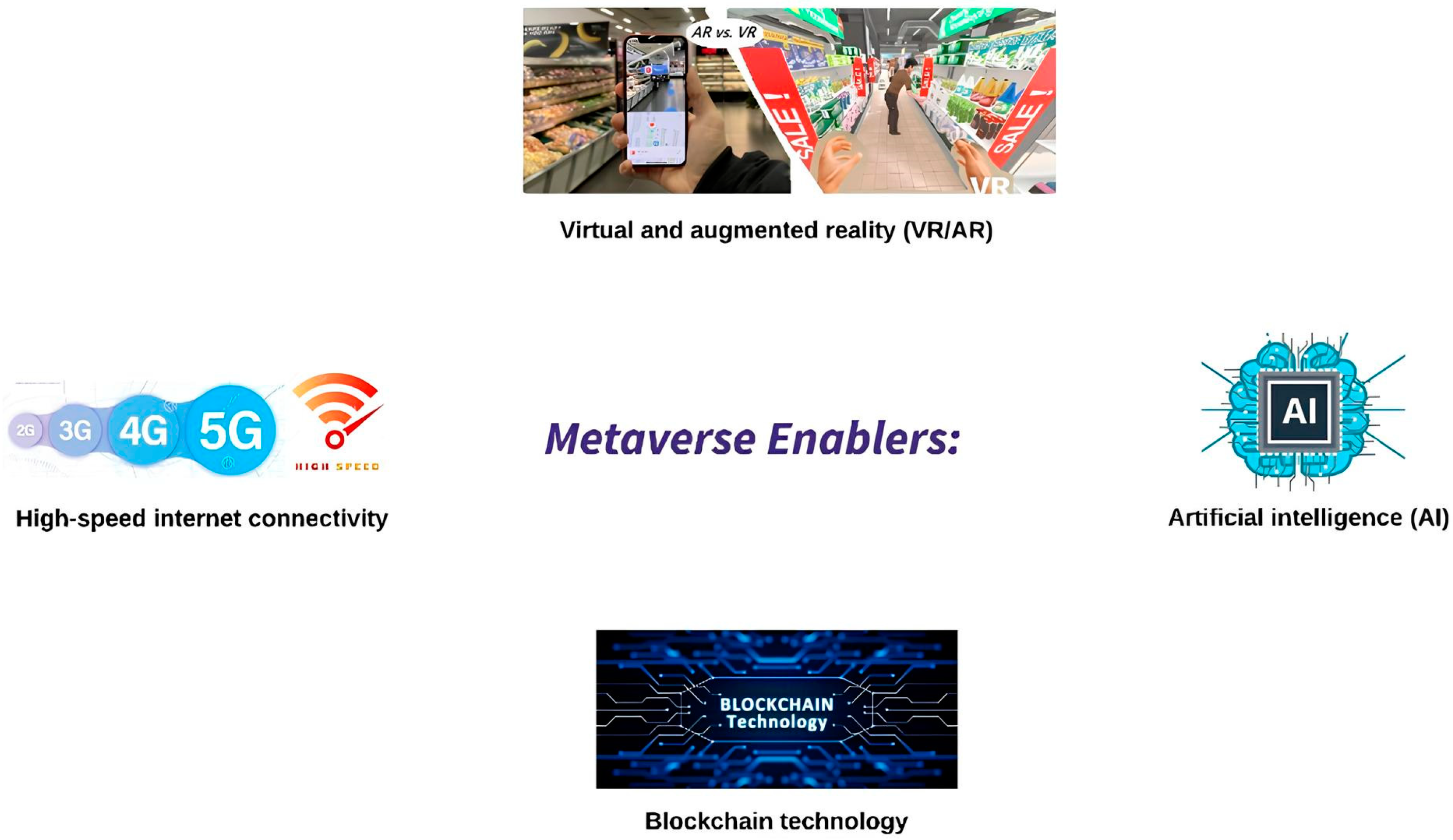

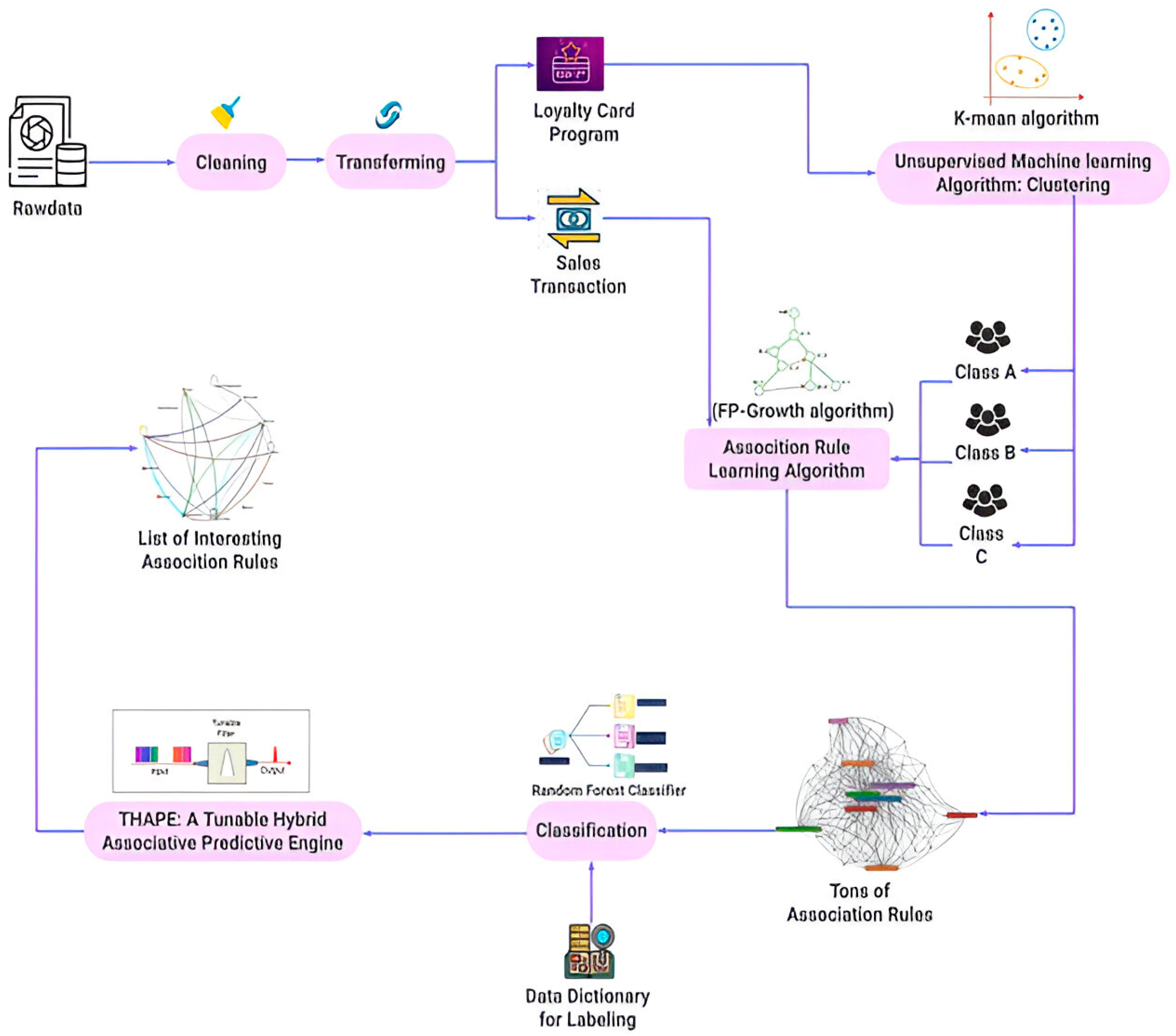

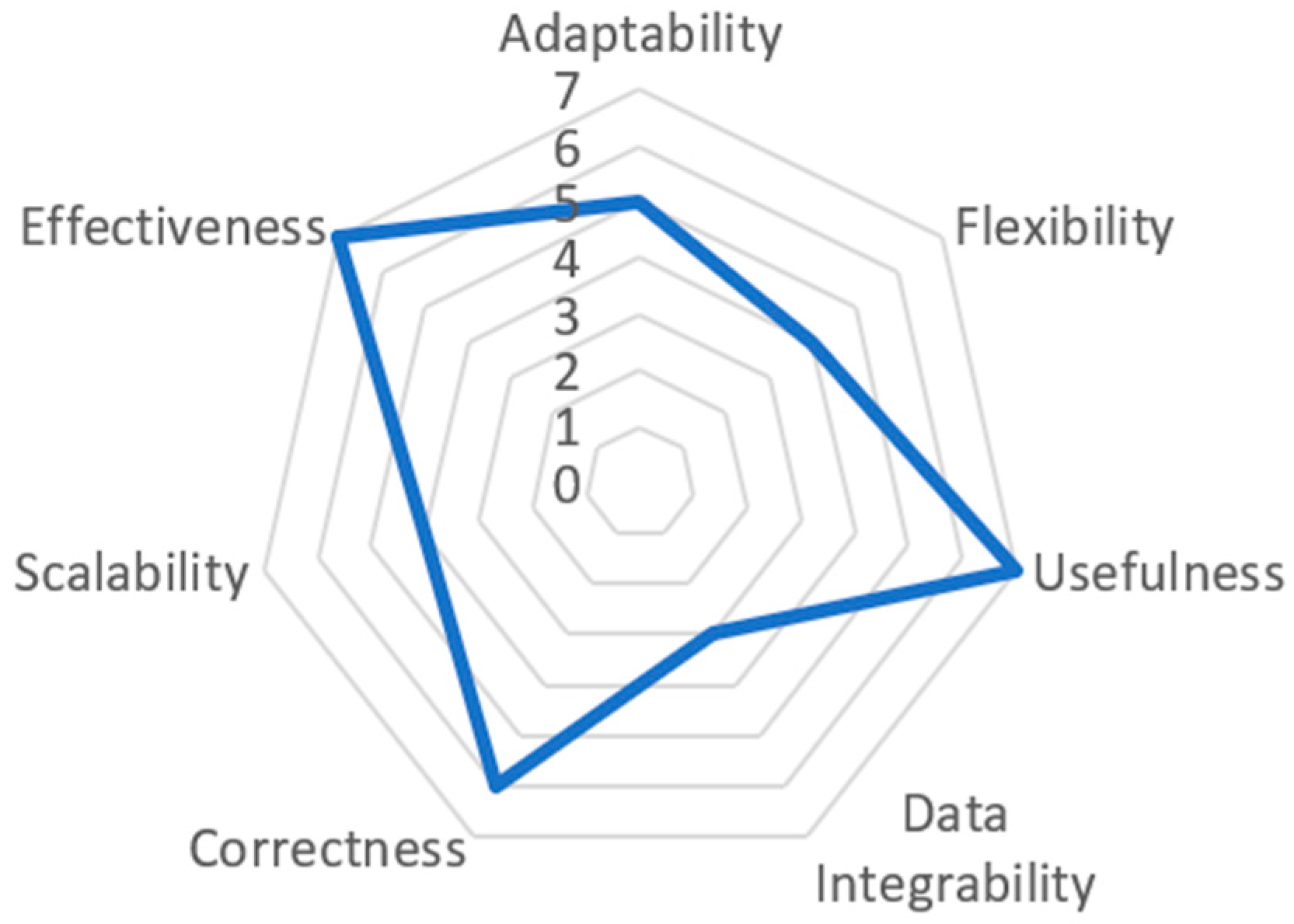
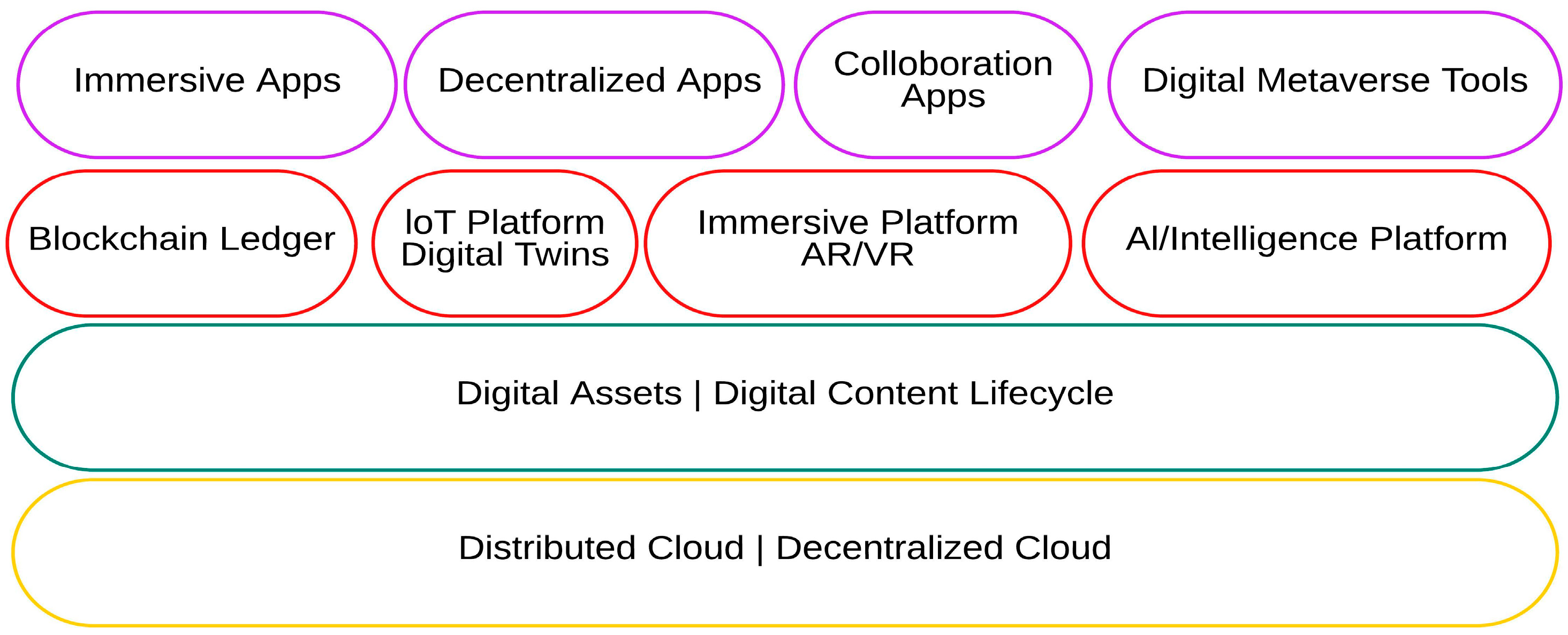
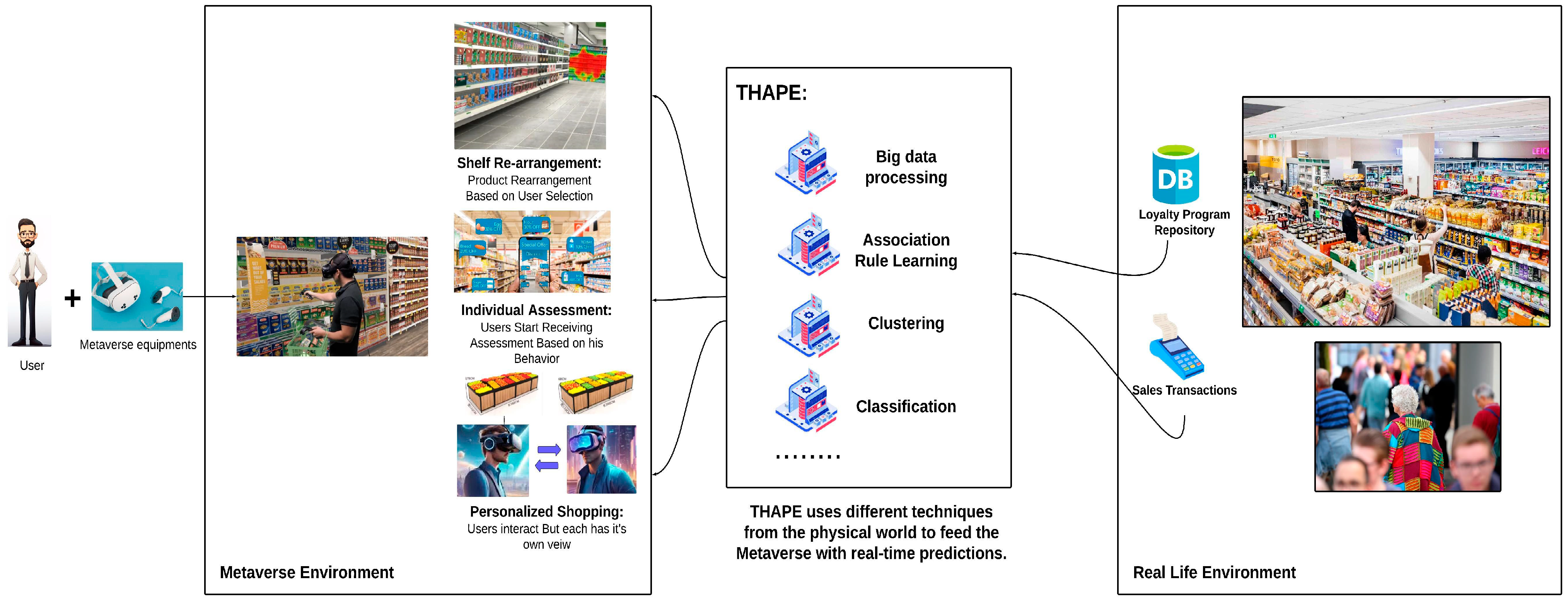
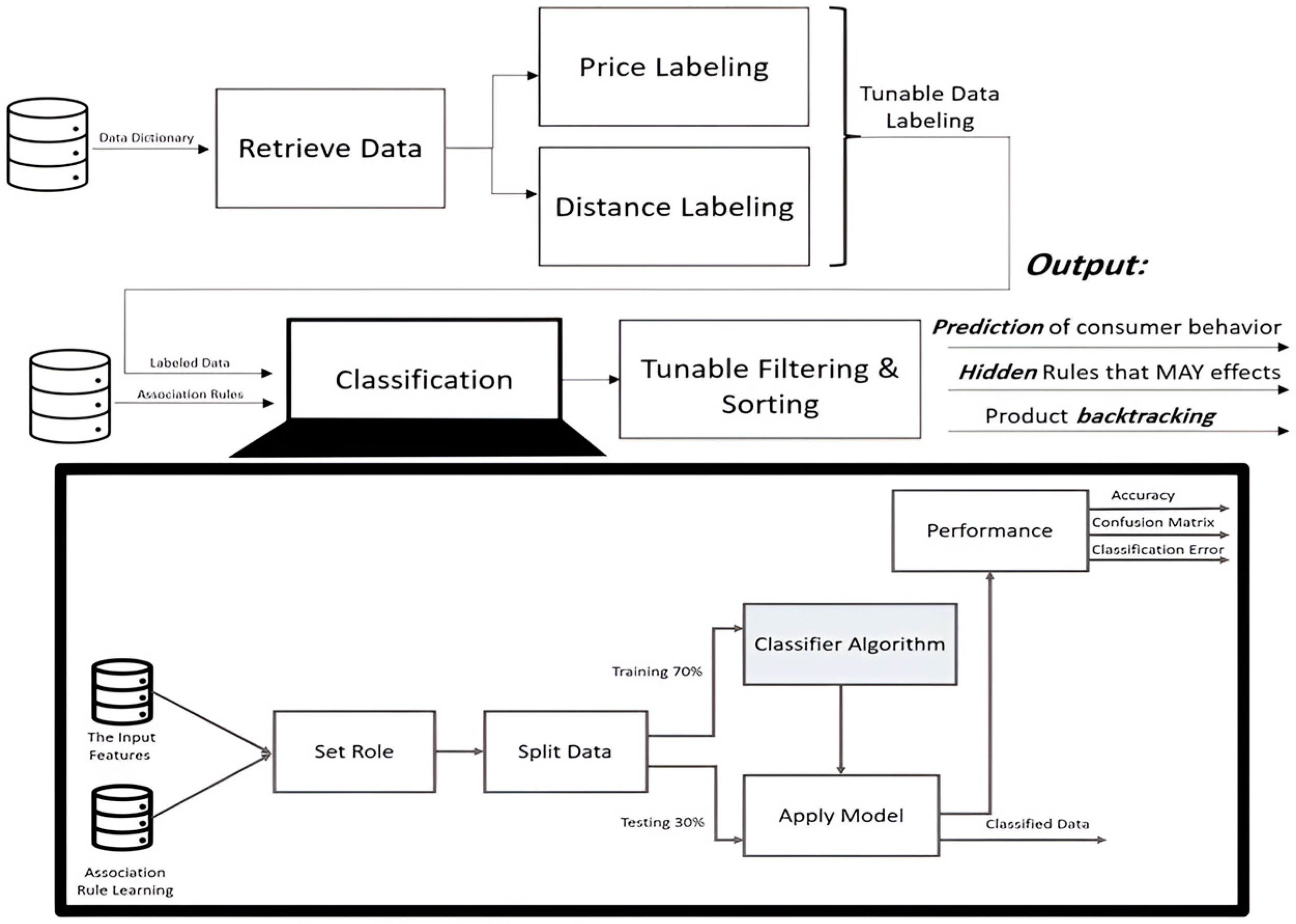
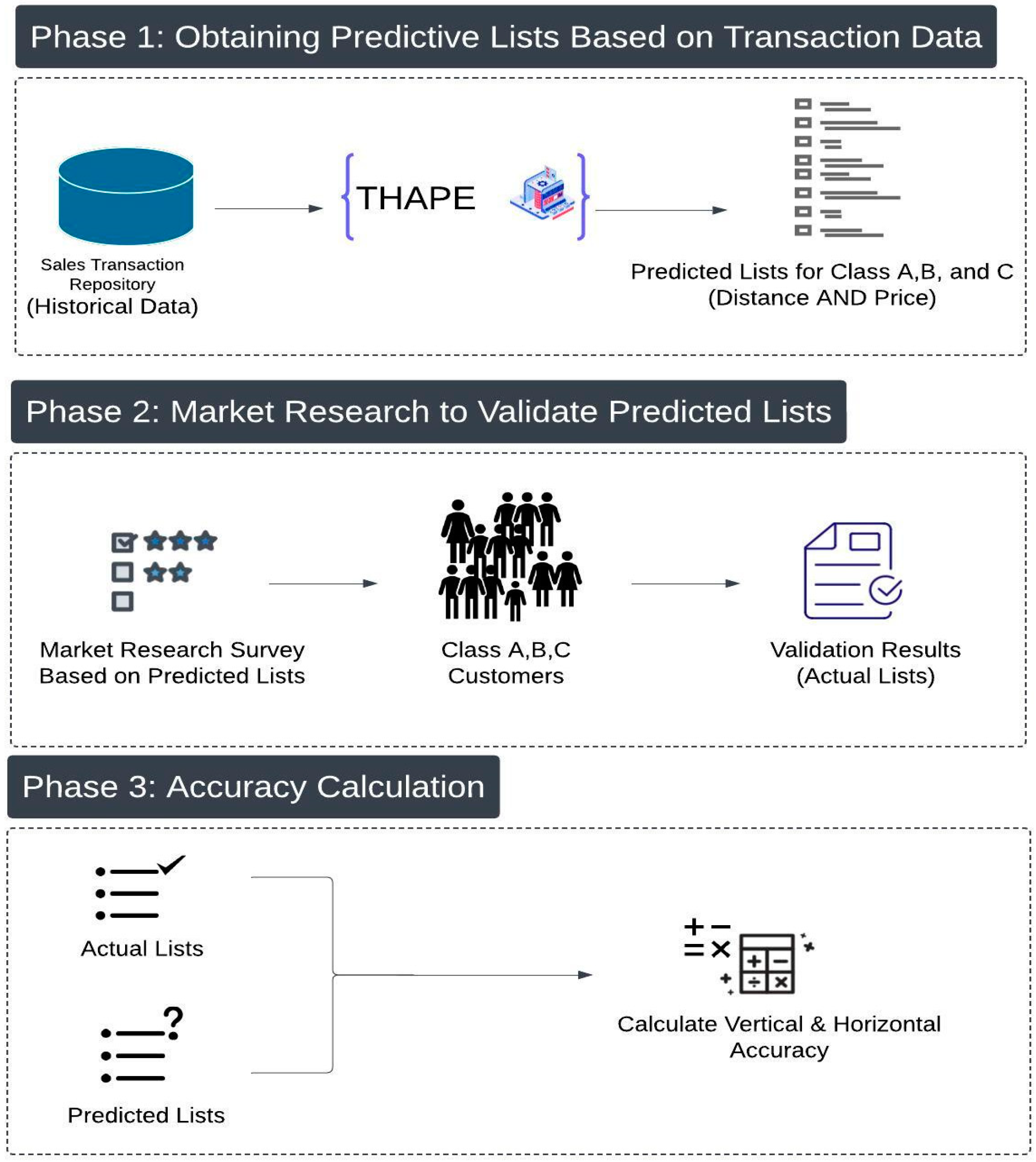
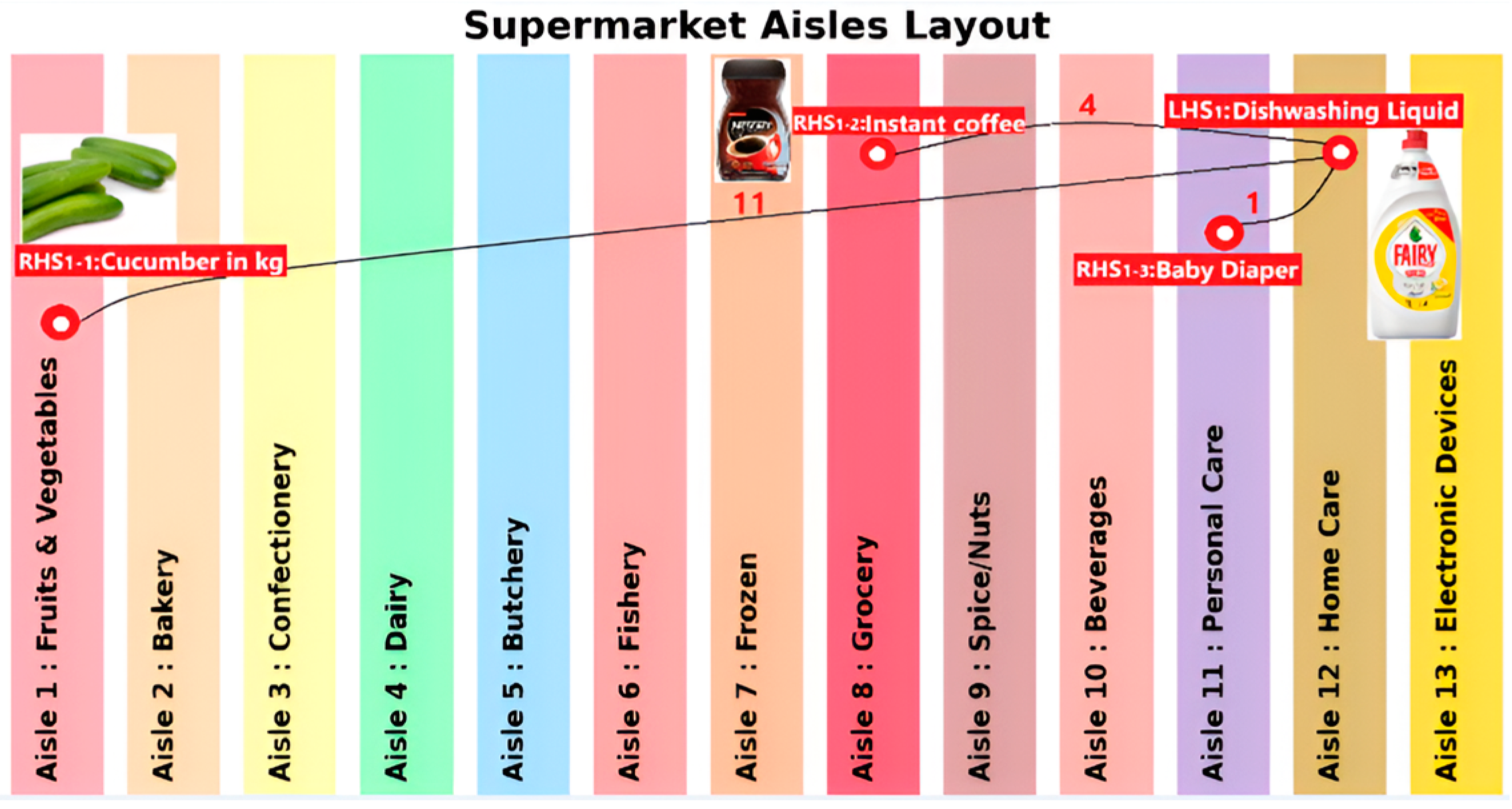

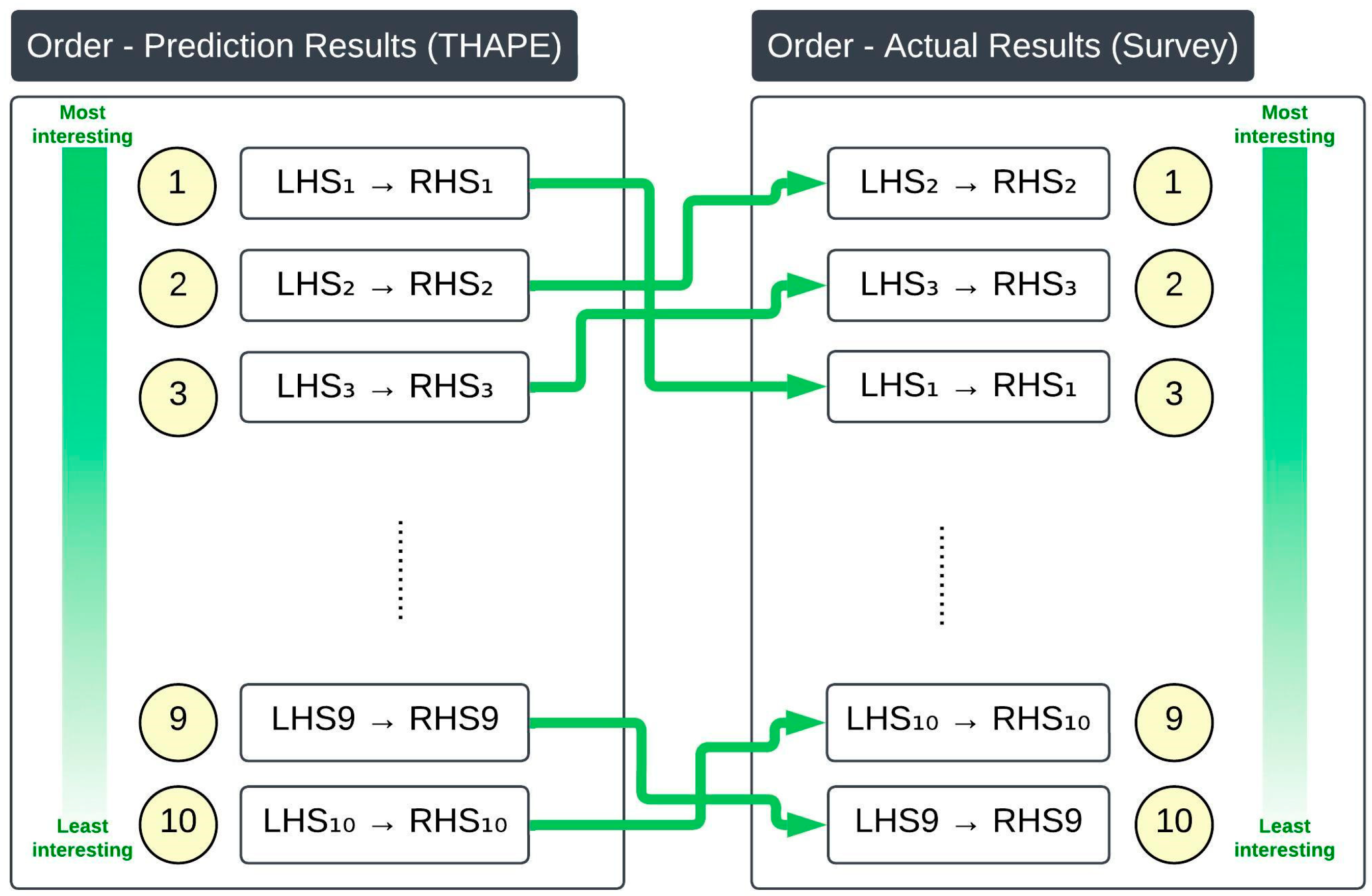
| Category | Description Summary | Key Components |
|---|---|---|
| Framework | ALMAA framework (adaptive learning model for ai agents). Using detailed user interaction logs, the framework shows good results in understanding and analyzing adaptive AI in virtual settings of Epic Games and AltspaceVR [42]. | AI agents |
| A deep learning framework with multiple CNNs for feature extraction and prediction, used to forecast eye fixations in a task-oriented virtual environment in virtual reality. Using users’ eye tracking data, FixationNet outperformed the state-of-the-art method (DGaze) by 19.8%. Strong correlations were found between eye fixations and factors like historical gaze positions, task-related objects, saliency information, and head rotation velocities [43]. | CNNs | |
| Recommendation system | The recommendation system is built using a Neural Collaborative Filtering (NCF) model, which generates recommendations based on purchase history and user interaction data in Amazon [16]. | NCF + CNN |
| Build a realistic and practical metaverse by pushing the frontier of fundamental technologies, including perception, computation, reconstruction, cooperation, and interaction [44]. | Cloud computing | |
| Virtual shopping mall system with different sensors (proximity sensor, visibility sensor, and touch Sensor) used to track the customer’s avatar and provide personalized product recommendations from real-life data, including sales transactions [30]. | Sensors |
| Field | Method | Objective | Outcomes | Year |
|---|---|---|---|---|
| Virtual reality + Collected sales transaction data [46] | Using the retail environment setup component to present an example of VR shopping applications developed with VRSI. | To help in abstracting the layers needed to set up VR technology on applications developed with Unity, and to provide data registration tools that monitor user activity from non-invasive data sources. | An example of a VR shopping application developed with VRSI was presented, and the public repository with all the data and source codes was made fully open. | 2024 |
| Virtual reality + Real experiment [47] | Employed a 2 (Interactivity: high vs. low) × 2 (Vividness: high vs. low) × 2 (Product type: leather chair vs. flower) between-subjects experiment design, with eight VR store versions created to correspond to eight scenarios. Each participant was randomly assigned to experience a VR store scenario. | Investigated how virtual system characteristics impacted consumers’ impulsive buying decisions in VR-based online shopping and contributed to the growing body of e-commerce studies on online impulse buying and the effectiveness of VR systems on consumers’ experiences and consequent behavioral decisions. | The path coefficients of the six proposed hypotheses related to the stimuli–organism route were statistically significant, indicating that VR shopping platforms evoke both individual cognitive and affective reactions. Additionally, impulsiveness positively influenced the urge to buy impulsively. | 2023 |
| Immersive/mixed reality + MNIST dataset and Unity data [38] | Deep learning modules for all recognitions. Unity for the development of the virtual environment. NLP component incorporated transformer modules such as BERT, GPT-3, and Tortoise-TTS. | To develop a social practice-based architecture for social NPCs in the Metaverse, enabling them to adapt their behavior according to the current situation in a supermarket scenario. | Enabled the agent to adapt its behavior according to the current situation in a supermarket scenario, recognizing objects, emotions, and gestures, and using NLP to fine-tune pre-trained models. | 2022 |
| Virtual reality + Online data collected [38] | Collecting data through a structured survey utilizing the Likert scale with five response items. The data analysis was carried out using Structural Equation Modeling (SEM) in determining the causal relationship between latent variables and the dependent variable. | To identify key factors influencing consumers to adopt metaverse technology, specifically examining the roles of perceived consumer experience, perceived brand engagement, and gamification. | The results showed that the perceived consumer experience had positive and significant effects on the intention to use Metaverse technology of a specific brand. The results showed that all indicators of Perceived Consumer Experience had a loading factor > 0.7, indicating good convergent validity. The path coefficient test showed that the latent variables had good reliability. | 2022 |
| Augmented reality + WLAN data [24] | Using virtual supermarket simulation and combining an add-on RGB camera on the augmented reality (AR) headset to track the screen of the participants. | To investigate the influences of health-related nutrition apps on shopping behavior using a virtual supermarket simulation and a virtual replica smartphone with augmented virtuality features. | The study showed high potential in understanding the purchasing decisions of participants and enhancing the effectiveness of health-oriented applications. Also, the study found that the hybrid approach using an RGB camera and fiducial markers allowed for high-quality tracking of the participant’s smartphone screen and integration of real-world apps into the simulation. | 2021 |
| Immersive/mixed reality + Laboratory experiments data [45] | The analysis used covariance-based structural equation modeling (CB SEM) and a multivariate analysis of variance (MANOVA) to test the effects of treatment manipulation on the dependent variables. | To develop and experimentally validate a theoretical model that explains how immersion affects adoption of VR shopping environments. | Immersion had a positive effect on perceived telepresence, but a negative effect on perceived product diagnosticity. However, when controlling readability, high immersion had a positive influence on the intention to reuse the shopping environment. | 2019 |
| Class A | Class B | Class C | |
|---|---|---|---|
| i. Entire class average spend/month | 5,855,404 SR | 3,224,208 SR | 2,732,594 SR |
| ii. Number of consumers in the Class | 6502 | 10,176 | 12,669 |
| iii. Average visit/month | 4.086 | 1.153 | 0.683 |
| iv. Average spend/month (=I ÷ ii) | 900.690 | 316.792 | 215.712 |
| v. Individual average spend/visit (=iv ÷ iii) | 220.4 SR | 274.8 SR | 315.8 SR |
| Aspects | Concern | Remarks |
|---|---|---|
| Adaptability | Relevance of dimensions: responses varied regarding the relevance of these dimensions. | While some indicated that the outcome and interpretation being pursued determine their significance, others affirmed their importance in understanding consumer behavior. |
| Flexibility | Adapting to market trends and consumer behaviors. | Participants raised concerns about the framework’s ability to adapt to changing market trends and consumer behaviors. They emphasized the importance of flexibility in strategies to ensure continued relevance and effectiveness in analyzing consumer behavior. |
| Usefulness | Assessing customer purchases and evaluating rules: some participants favored this approach, emphasizing its potential to assess customer purchases and evaluate rules. | However, others suggested alternative methods, such as splitting the data into training and testing sets or applying the methodology to a sample customer and then assessing their purchases, as they believed that using a survey could introduce challenges and potential inaccuracies. |
| Data Integrability | Ensuring seamless integration of diverse data sources. | Some participants highlighted the need for the seamless integration of diverse data sources to enhance the accuracy and comprehensiveness of the analysis. They stressed the importance of ensuring that data from various sources can be effectively combined and analyzed to provide meaningful insights into consumer behavior. |
| Correctness | Achieving expected results: some participants expressed skepticism, stating that while it sounds good, the expected results may not be achieved. | A slightly different response indicated concern that changing the arrangement may confuse and frustrate customers. Another participant acknowledged the value of trying the approach but suggested applying manual filtering as needed. |
| Scalability | Handling increasing data volumes. | Participants expressed concerns about the framework’s scalability to handle increasing data volumes as the business grows. They emphasized the importance of ensuring that the system can efficiently process and analyze large amounts of data without compromising performance or accuracy. |
| Effectiveness | Enhancing virtual shopping experience: they expressed their interest and praised its effectiveness. | They highlighted that through virtual shopping, certain products can be shown when customers make a purchase, and additional product suggestions can be personalized based on their purchase history. Participants also noted that this approach may lead to increased basket size, improved purchasing habits and customer loyalty. Overall, they agreed that this approach would be relied upon, as the Metaverse makes it easier to remind users of specific items based on the association rules. |
| Consumer Perspectives | Business Perspectives |
|---|---|
|
|
| Relations (Prediction) | Class A | Class B | Class C | |||
|---|---|---|---|---|---|---|
| Horizontal Accuracy | Vertical Accuracy | Horizontal Accuracy | Vertical Accuracy | Horizontal Accuracy | Vertical Accuracy | |
| LHS1→RHS1-1 | 43.3% | 80% | 43.2% | 60% | 30% | 90% |
| LHS2→RHS2-1 | 28.5% | 30% | 59.3% | 90% | 20% | 20% |
| LHS3→RHS3-1 | 40.2% | 80% | 32.2% | 60% | 50% | 80% |
| LHS4→RHS4-1 | 32.1% | 60% | 28.8% | 60% | 50% | 70% |
| LHS5→RHS5-1 | 43% | 70% | 28% | 50% | 40% | 80% |
| LHS6→RHS6-1 | 24.4% | 60% | 54.2% | 70% | 30% | 70% |
| LHS7→RHS7-1 | 51.3% | 70% | 44.1% | 70% | 50% | 60% |
| LHS8→RHS8-1 | 51.3% | 70% | 41.5% | 80% | 40% | 80% |
| LHS9→RHS9-1 | 47.2% | 80% | 58.5% | 30% | 50% | 50% |
| LHS10→RHS10-1 | 47.2% | 60% | 23.7% | 90% | 70% | 80% |
| Average | 40.8% | 66% | 41.4% | 66% | 43% | 68% |
| Relations (Prediction) | Class A | Class B | Class C | |||
|---|---|---|---|---|---|---|
| Horizontal Accuracy | Vertical Accuracy | Horizontal Accuracy | Vertical Accuracy | Horizontal Accuracy | Vertical Accuracy | |
| LHS1→RHS1-1 | 24.9% | 20% | 30.5% | 50% | 51.3% | 100% |
| LHS2→RHS2-1 | 43.5% | 90% | 30.5% | 50% | 47.54% | 90% |
| LHS3→RHS3-1 | 41.5% | 90% | 49.2% | 100% | 33.2% | 40% |
| LHS4→RHS4-1 | 48.7% | 80% | 57.6% | 70% | 36.6% | 60% |
| LHS5→RHS5-1 | 33.4% | 80% | 20.3% | 60% | 44.15% | 90% |
| LHS6→RHS6-1 | 36.8% | 90% | 55.9% | 60% | 47.16% | 80% |
| LHS7→RHS7-1 | 37% | 70% | 44.9% | 70% | 47.92% | 50% |
| LHS8→RHS8-1 | 27.5% | 80% | 34.7% | 70% | 39.24% | 90% |
| LHS9→RHS9-1 | 16.1% | 90% | 22.9% | 90% | 46.03% | 60% |
| LHS10→RHS10-1 | 50.8% | 10% | 20.3% | 100% | 31.69% | 100% |
| Average | 36% | 70% | 36.7% | 72% | 42.9% | 76% |
Disclaimer/Publisher’s Note: The statements, opinions and data contained in all publications are solely those of the individual author(s) and contributor(s) and not of MDPI and/or the editor(s). MDPI and/or the editor(s) disclaim responsibility for any injury to people or property resulting from any ideas, methods, instructions or products referred to in the content. |
© 2025 by the authors. Licensee MDPI, Basel, Switzerland. This article is an open access article distributed under the terms and conditions of the Creative Commons Attribution (CC BY) license (https://creativecommons.org/licenses/by/4.0/).
Share and Cite
Alawadh, M.; Barnawi, A. Empowering Retail in the Metaverse by Leveraging Consumer Behavior Analysis for Personalized Shopping: A Pilot Study in the Saudi Market. J. Theor. Appl. Electron. Commer. Res. 2025, 20, 63. https://doi.org/10.3390/jtaer20020063
Alawadh M, Barnawi A. Empowering Retail in the Metaverse by Leveraging Consumer Behavior Analysis for Personalized Shopping: A Pilot Study in the Saudi Market. Journal of Theoretical and Applied Electronic Commerce Research. 2025; 20(2):63. https://doi.org/10.3390/jtaer20020063
Chicago/Turabian StyleAlawadh, Monerah, and Ahmed Barnawi. 2025. "Empowering Retail in the Metaverse by Leveraging Consumer Behavior Analysis for Personalized Shopping: A Pilot Study in the Saudi Market" Journal of Theoretical and Applied Electronic Commerce Research 20, no. 2: 63. https://doi.org/10.3390/jtaer20020063
APA StyleAlawadh, M., & Barnawi, A. (2025). Empowering Retail in the Metaverse by Leveraging Consumer Behavior Analysis for Personalized Shopping: A Pilot Study in the Saudi Market. Journal of Theoretical and Applied Electronic Commerce Research, 20(2), 63. https://doi.org/10.3390/jtaer20020063






